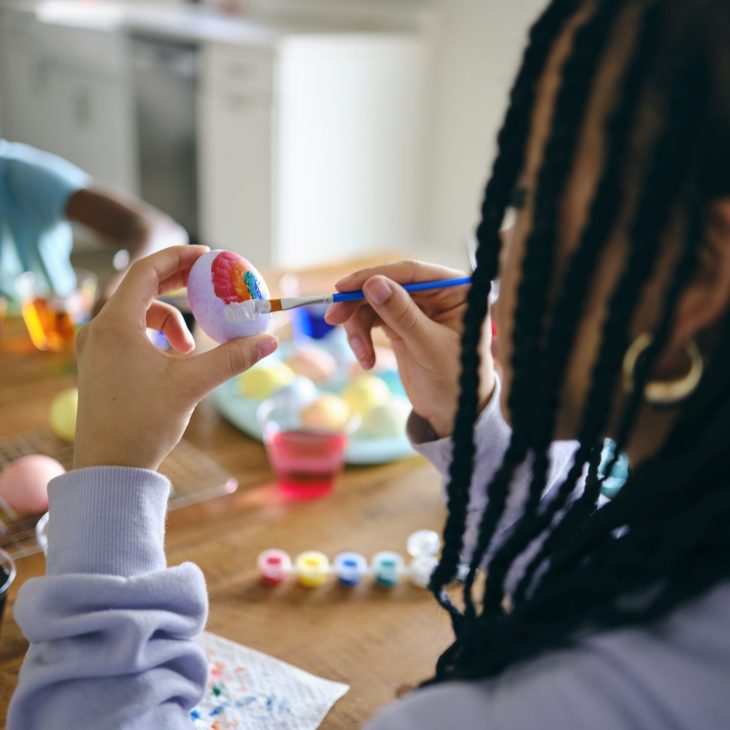Many Shades of Hope: Finding Inspiration in Easter Eggs
April 8, 2023

This week my family dyed eggs for Easter. We went to the trouble of buying white eggs instead of the usual brown, got a $2 egg coloring kit–neon colors–and took on a little after-dinner project.
We mixed each of the six colored tablets with vinegar and warm water, and we set out a tray and towels to avoid staining anything. The kids bickered over who got how many eggs and how long they should leave the eggs in the dye. Thanks to a little patience and good humor, our reward was a carton of bright, beautiful colors that we’ll admire and snack on for the rest of the week.
Dyeing eggs has been an Easter practice in my family for as long as I can remember. There are photos of me as a baby with a pile of fresh, hand-colored eggs. When I was a child, we dyed real eggs because plastic eggs weren’t the easy, ubiquitous option they are now. As a college student, my sister and I nostalgically dyed eggs when we visited home at Easter, always using regular food coloring instead of special kits. Although the specifics have grown over time, the sensations of the experience remain the same: the warm smooth hard-boiled eggs, the smell of vinegar, the bright colors, the sense that we’re doing something both simple and meaningful.
As you read this, Christians are nearing the end of our Holy Week. The week, which culminates in Easter, is the apex of the Christian year. It begins with Palm Sunday, a commemoration of Jesus’ procession into Jerusalem, one of his last acts. It continues into the final three days, sometimes referred to as the Triduum. Maundy Thursday or Holy Thursday commemorates Jesus’ last supper with his disciples. Good Friday is a solemn observance of Jesus’ death, and Easter is the joyful celebration of Jesus’ resurrection. While different denominations and congregations have their own customs, it’s common to observe the week in community and read familiar stories together. Over the course of the individual days, the tone moves from purposeful and proclamatory, to reflective, to grief-stricken, to joyful celebration of life.
Easter is a reminder that in the face of death, hope can bring new life.
What does all this have to do with colored eggs? The egg is perhaps the most widely adopted symbol of Easter for both religious and secular observers. An egg, in its original bird-laid form, encompasses both life and death. On first look, it appears dead outside, like a rock. But with careful observance, life (a baby chick!) emerges miraculously from what we thought was lifeless. Christians often use the egg’s combination of death and life to teach about Jesus. The central miracle and mystery of Christian faith is that Jesus died — was, in fact, murdered by authorities — and then days later emerged from a tomb into the fullness of life. On Easter and on every day of the year, Jesus reminds us that death is not the end of the story.
No matter your beliefs or religious practice, many things in our world can feel dead but prove to be alive. Perhaps your hometown faced an economic crisis following business closures; can you see life in local networks that creatively care for community members? Maybe you or a loved one have disability by mental illness or substance abuse; is the opportunity for steadfast presence with those we love an invitation to new life? The deep divisions and angry polarization in our nation leave many of us hopeless; relationships with a wide variety of people who hold wide spectra of beliefs can be a renewing antidote.
Easter is a reminder that in the face of death, hope can bring new life. At Interfaith America, we are relentlessly hopeful, seeing life instead of death through relationships and communities across the country. Interfaith cooperation, the ways our religiously diverse beliefs and values shape a shared society, gives us life each day. What in your life seems dead but is alive?
Share
Related Articles
Racial Equity
A Year After George Floyd’s Murder: How Black Interfaith Can Give Hope to America
American Civic Life
American Civic Life
We Commemorate, We Commit: Out of Catastrophe, a Conversation on Connection and Repair



